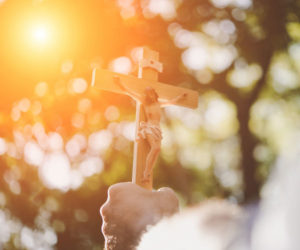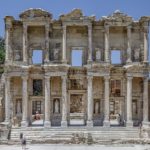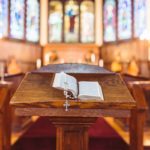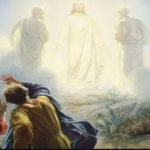Re: Christian Turks of the Dobruja
Again, some pages later, in the chapter headed ‘Rest of the story of ‘Alāeddīn Kaiqobād b. Ferāmurz, nephew of Sultan Mas’ūd, and conquest of Bilejik by ‘Osmān b. Ertoghrul, King of the Ghazis’, the Dobruja Turks reappear. Following the story of ‘Osmān’s election as khān and the conquest of Bilejik in 699/1300, Yaz j
j oghlu speaks of the increasing immigration of Turks from the Anatolian interior into the lands of ‘Osmān, into Ayd
oghlu speaks of the increasing immigration of Turks from the Anatolian interior into the lands of ‘Osmān, into Ayd n and Qaras
n and Qaras (i.e. the Troas), adding with regard to the last-named:
(i.e. the Troas), adding with regard to the last-named:
 .
.
This is repeated and amplified in Yaz j
j oghlu’s last chapter, ‘The events after the death of Ghāzān Khān’, following a short account of the situation in Anatolia after the appearance of Timurtash b. Emīr Chōban in 1318.
oghlu’s last chapter, ‘The events after the death of Ghāzān Khān’, following a short account of the situation in Anatolia after the appearance of Timurtash b. Emīr Chōban in 1318.
 , for in the troubled state of Anatolia no more news comes through from there. And in Rumeli the Bulgarian princes rise up and get the better of the basileus. They occupy the major part of Rumeli. That is why those (Muslims), tired of them, emigrate and go over to Anatolia. ‘As to those who remained in Rumeli, after the death of Ṣar
, for in the troubled state of Anatolia no more news comes through from there. And in Rumeli the Bulgarian princes rise up and get the better of the basileus. They occupy the major part of Rumeli. That is why those (Muslims), tired of them, emigrate and go over to Anatolia. ‘As to those who remained in Rumeli, after the death of Ṣar Ṣalt
Ṣalt q their race renounced the faith and forgot it.’ [47]
q their race renounced the faith and forgot it.’ [47]
A number of general observations must be made before entering a detailed analysis of the account. It covers a period of much more than a century (from about 1261 to about 1395), which made it necessary to give it in instalments at the chronologically appropriate places. As a whole, the account fills in the MS. Topkapi Sarayi, Revan K., No. 1391, eleven pages (out of more than 900), of which seven pages, containing the §§ 1-9, occupy as a solid block ff. 373b-376b, and three pages, §§ 11-13, as another block, ff. 415a-416a, whereas the rest, the §§ 10, 14, and 15, appear as small passages on ff. 41 Ib, (about) 430, and 444a respectively.
652
The account falls visibly into four different stories: that of (1) ‘Izzeddīn Kaikāūs, (2) the Dobruja Turks, (3) the Karaferia family, (4) Ṣar Ṣalt
Ṣalt q and Baraq. Of these four stories that of ‘Izzeddīn Kaikāūs derives from Ibn Bībī: in §§ 1 and 5 the original is rendered exactly and in §§ 3, 4, 6, and 8 with some adaptations which can easily be established by comparison with the Persian text and will later be noted and discussed. For the other three stories we have no source at hand, nevertheless, we can say that these, too, must have undergone similar adjustments, since Yaz
q and Baraq. Of these four stories that of ‘Izzeddīn Kaikāūs derives from Ibn Bībī: in §§ 1 and 5 the original is rendered exactly and in §§ 3, 4, 6, and 8 with some adaptations which can easily be established by comparison with the Persian text and will later be noted and discussed. For the other three stories we have no source at hand, nevertheless, we can say that these, too, must have undergone similar adjustments, since Yaz j
j oghlu had to knit all these stories together into a tolerably consistent narrative. The story of Ṣar
oghlu had to knit all these stories together into a tolerably consistent narrative. The story of Ṣar Ṣalt
Ṣalt q and Baraq (§ 12) stands out as a unity, though it is announced by small ‘fore-runners’ in the preceding §§ 2, 9, and 10 (‘and Ṣar
q and Baraq (§ 12) stands out as a unity, though it is announced by small ‘fore-runners’ in the preceding §§ 2, 9, and 10 (‘and Ṣar Ṣalt
Ṣalt q with them’), preparing the reader for the holy man’s presence in the Dobruja, and other ‘fore-runners’ in §§ 4, 7, 8, and 11, introducing the future Baraq, and still finds an echo in § 15 (Ṣar
q with them’), preparing the reader for the holy man’s presence in the Dobruja, and other ‘fore-runners’ in §§ 4, 7, 8, and 11, introducing the future Baraq, and still finds an echo in § 15 (Ṣar Ṣalt
Ṣalt q’s death). This use of ‘fore-runners’ and the isolated occurrence of tekvur instead of fāsilyevs, let alone its strictly hagiographic character, indicate for this story a separate origin. Similarly distinct is the Karaferia story, represented by § 13, with ‘fore-runners’ in §§ 4,6, 7, 8, and 11.
q’s death). This use of ‘fore-runners’ and the isolated occurrence of tekvur instead of fāsilyevs, let alone its strictly hagiographic character, indicate for this story a separate origin. Similarly distinct is the Karaferia story, represented by § 13, with ‘fore-runners’ in §§ 4,6, 7, 8, and 11.
The Karaferia story is of pre-eminent importance because it provides, itself, the means to understand how Yaz j
j oghlu got hold of it and to assess its true character, and also because it links the whole account with the author’s own time. The story was obviously told to him by the two brothers from Zikhna when, after the accession of Murād II in 1421, they came to the capital, i.e. Adrianople, in order to have their privilege renewed at the chancery. Such a renewal was due at the beginning of each new reign. Yaz
oghlu got hold of it and to assess its true character, and also because it links the whole account with the author’s own time. The story was obviously told to him by the two brothers from Zikhna when, after the accession of Murād II in 1421, they came to the capital, i.e. Adrianople, in order to have their privilege renewed at the chancery. Such a renewal was due at the beginning of each new reign. Yaz j
j oghlu says that it was made ‘recently’, which gives very strong support to the acceptance of 1424 as the date of his work [48]; it also conveys the impression that he had personally dealt with the matter. One thing is fairly certain: the Seljuk origin of the family was mentioned in their diploma since, as we are expressly told, it was for this reason that Bāyezīd I had granted the privilege. Without claiming literal accuracy, we may imagine how Yaz
oghlu says that it was made ‘recently’, which gives very strong support to the acceptance of 1424 as the date of his work [48]; it also conveys the impression that he had personally dealt with the matter. One thing is fairly certain: the Seljuk origin of the family was mentioned in their diploma since, as we are expressly told, it was for this reason that Bāyezīd I had granted the privilege. Without claiming literal accuracy, we may imagine how Yaz j
j oghlu met Dīmitrī Sulṭān and Mīkhō Sulṭān: when the request for the renewal of this certainly exceptional privilege was laid before the chief of the chancery, i.e. as we assume, Yaz
oghlu met Dīmitrī Sulṭān and Mīkhō Sulṭān: when the request for the renewal of this certainly exceptional privilege was laid before the chief of the chancery, i.e. as we assume, Yaz j
j oghlu himself, the translator of Ibn Bībī would hardly have missed such an occasion to converse with descendants of the Seljuks; surely he summoned these interesting visitors to his presence in order to hear from them as much as possible of their story. After this we can have no doubt as to the character of the Karaferia story; it is oral tradition, handed down from generation to generation in a family claiming royal origin — indeed, the two brothers put ‘sultan’ after their names — a story certainly not to be entirely believed but neither to be entirely rejected. There is one point in it which strikes us at once: the relation in which it sets the Turks of Karaferia and Zikhna with those
oghlu himself, the translator of Ibn Bībī would hardly have missed such an occasion to converse with descendants of the Seljuks; surely he summoned these interesting visitors to his presence in order to hear from them as much as possible of their story. After this we can have no doubt as to the character of the Karaferia story; it is oral tradition, handed down from generation to generation in a family claiming royal origin — indeed, the two brothers put ‘sultan’ after their names — a story certainly not to be entirely believed but neither to be entirely rejected. There is one point in it which strikes us at once: the relation in which it sets the Turks of Karaferia and Zikhna with those
653
of the Dobruja (§ 11) — let us recall that Karaferia and Zikhna are two of the three places where Gagauz are found outside the Dobruja.
Lastly, the Dobruja story (§§ 2, 9, 10, 14, and 15) provides us likewise with a clue concerning its provenance and value: it is obviously a tradition kept alive in those families of Qaras which descended from the Dobruja Turks. As we shall see, such families can be assumed to have existed and even to have played no small role in early Ottoman history. Some connexion must have subsisted with their former abode, for they call it ‘Dobruja-éli’, i.e. by the name it received only half a century after they had left it. [49] Again, one point strikes us at once: the mention of Turks who stayed on in the Dobruja and there lost their Muslim faith, i.e. became Christians. This refers beyond any doubt to our Gagauz. The last paragraph (§ 15) would by itself already make it sufficiently clear that the Dobruja Turks had come from Anatolia — for, when they arrived, they were Muslims, and so were also the Dobruja Turks who joined the Seljuk prince at Karaferia (§ 11). From both places ‘Muslims’ are said to have returned to Anatolia (§ 13 and §§ 14-15), evidently in both cases to Qaras
which descended from the Dobruja Turks. As we shall see, such families can be assumed to have existed and even to have played no small role in early Ottoman history. Some connexion must have subsisted with their former abode, for they call it ‘Dobruja-éli’, i.e. by the name it received only half a century after they had left it. [49] Again, one point strikes us at once: the mention of Turks who stayed on in the Dobruja and there lost their Muslim faith, i.e. became Christians. This refers beyond any doubt to our Gagauz. The last paragraph (§ 15) would by itself already make it sufficiently clear that the Dobruja Turks had come from Anatolia — for, when they arrived, they were Muslims, and so were also the Dobruja Turks who joined the Seljuk prince at Karaferia (§ 11). From both places ‘Muslims’ are said to have returned to Anatolia (§ 13 and §§ 14-15), evidently in both cases to Qaras across the Dardanelles; this gives to understand that some of their kinsfolk had renounced Islam and stayed behind, as indeed the §§ 13 and 15 clearly show. There can be no doubt that the essential contents of § 2 come from the Qaras
across the Dardanelles; this gives to understand that some of their kinsfolk had renounced Islam and stayed behind, as indeed the §§ 13 and 15 clearly show. There can be no doubt that the essential contents of § 2 come from the Qaras tradition, which must have recorded explicitly the Anatolian origin of the Turks of the Dobruja and the main facts concerning their immigration there, above all the name of the Sultan whose exile in Constantinople had given rise to the whole adventure.
tradition, which must have recorded explicitly the Anatolian origin of the Turks of the Dobruja and the main facts concerning their immigration there, above all the name of the Sultan whose exile in Constantinople had given rise to the whole adventure.
In fact, ‘Izzeddīn Kaikāūs must somehow have appeared also in the two other stories, as Baraq’s father in the one and as ancestor of the Karaferia family in the other — without mention of his stay in the Byzantine empire and his subsequent escape both stories would remain incomprehensible. Thus, Yaz j
j oghlu had a good reason to work the three stories into Ibn Bībī’s account of ‘Izzeddīn and to knit them together as closely as possible. How he proceeded will be seen by the separate analysis of each paragraph.
oghlu had a good reason to work the three stories into Ibn Bībī’s account of ‘Izzeddīn and to knit them together as closely as possible. How he proceeded will be seen by the separate analysis of each paragraph.
§ 1. As already stated, this is a faithful rendering of Ibn Bībī. There is no need here for a discussion of the facts since they are well known from the Byzantine historians, who on the whole are in agreement with Ibn Bībī. However, the latter shows ‘Izzeddīn as sailing directly to Istanbul, whereas

















